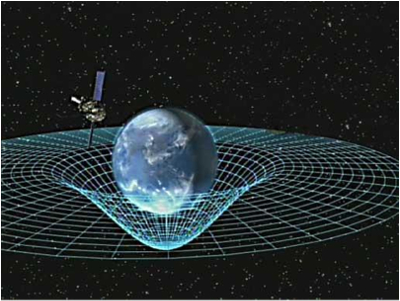Gravitational waves are ripples in the fabric of space-time. They are caused by changes in the amount of mass or energy in a particular area of space.
Space and time were once thought to be separate and fixed. However, in his special theory of relativity, Albert Einstein concluded that space and time are connected and relative to each other. In his general theory of relativity, he described “spacetime” as a flexible matrix that is continually reshaped by astronomical bodies and events. Similar to a bowling ball placed on a mattress, an astronomical object warps the spacetime around it, causing it to bend and curve.
 The greater an object’s mass, the greater the curvature around it. The distortions affect the way that other objects move through space. For example, the “dip” in spacetime created by the Earth’s mass is what holds the moon in its orbit.
The greater an object’s mass, the greater the curvature around it. The distortions affect the way that other objects move through space. For example, the “dip” in spacetime created by the Earth’s mass is what holds the moon in its orbit.
In contrast with these more stable distortions, gravitational waves are short-term distortions or wakes caused by high-energy events and the movements of astronomical bodies. While Einstein predicted the ripples in 1915, scientists were unable to detect them for the next century.
However, after upgrading equipment sensitivity in September 2015, researchers at the Laser Interferometer Gravitational-Wave Observatory (LIGO) promptly observed the gravity wave signals created by the collision of two black holes. The phenomenon, which generated 50 times the amount of power emitted by all the stars in the universe combined, occurred in a distant region of space approximately 1.3 billion years ago. As the resulting waves passed through the Earth, LIGO’s powerful sensors recorded their clear signals.
The discovery confirms the last prediction of Einstein’s general theory of relativity. The signals also provide strong evidence for the existence of binary black hole systems, where two black holes circle each other and eventually merge into one.
The universe is teeming with gravitational waves, and we now know how to detect them. The discovery will open up new research areas in gravitational astronomy, and could provide new ways of looking for astronomical phenomena.
Image credit: NASA
Video credit:SXS Project, Caltech LIGO, Creative Commons License